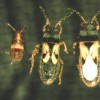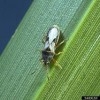 Currently, Captiva is the only chinch bug-resistant variety of St. Augustinegrass grown on sod farms in Florida. But since these pests have previously overcome their resistance to Floratam, it is highly probable that they will do the same with Captiva in the future. It is also desirable to have resistant varieties available with different agronomic qualities such as shade tolerance or drought tolerance. This 4-page fact sheet reports the results of a preliminary screening to detect resistance to chinch bugs, conducted at the UF/IFAS Everglades research station on 36 untested St. Augustinegrass lines. Written by Huangjun Lu and Ronald Cherry, and published by the UF Department of Horticultural Sciences, July 2014.
Currently, Captiva is the only chinch bug-resistant variety of St. Augustinegrass grown on sod farms in Florida. But since these pests have previously overcome their resistance to Floratam, it is highly probable that they will do the same with Captiva in the future. It is also desirable to have resistant varieties available with different agronomic qualities such as shade tolerance or drought tolerance. This 4-page fact sheet reports the results of a preliminary screening to detect resistance to chinch bugs, conducted at the UF/IFAS Everglades research station on 36 untested St. Augustinegrass lines. Written by Huangjun Lu and Ronald Cherry, and published by the UF Department of Horticultural Sciences, July 2014.
http://edis.ifas.ufl.edu/hs1239
Tag: Chinch Bugs
Silicon Effects on Resistance of St. Augustinegrass to Southern Chinch Bugs and Plant Disease
 Silicon (Si) is the second most common element on earth, but it is not considered an essential element for plant growth. However, a growing body of evidence has shown that Si can enhance plant resistance to insect pests. This 5-page fact sheet reports the results of a study to determine if silicon applications to St. Augustinegrass varieties increase the silicon in the plants and how this increased silicon affects development and survival of southern chinch bugs as well as development of plant diseases. Written by Alan L. Wright, Ron Cherry, Huangjun Lu, and Pamela Roberts, and published by the UF Department of Soil and Water Science, September 2013.
Silicon (Si) is the second most common element on earth, but it is not considered an essential element for plant growth. However, a growing body of evidence has shown that Si can enhance plant resistance to insect pests. This 5-page fact sheet reports the results of a study to determine if silicon applications to St. Augustinegrass varieties increase the silicon in the plants and how this increased silicon affects development and survival of southern chinch bugs as well as development of plant diseases. Written by Alan L. Wright, Ron Cherry, Huangjun Lu, and Pamela Roberts, and published by the UF Department of Soil and Water Science, September 2013.
http://edis.ifas.ufl.edu/ss589